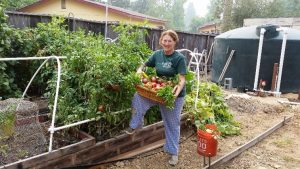Beating The Cold Season
It is snowing about 10 miles from my house, we have cold freezing nights and I am plotting so I can have early tomatoes. I love living in the mountains but it takes a lot more planning and effort to garden up here than when I lived in the central valley. There, I could plant my tomatoes in early March and enjoy them all summer long. If I did that here, those tender little plants wouldn’t stand a snowball’s chance in hell. Hence my time spent plotting. I have low tunnels for frost protection but that would mean pulling out bok choy, Swiss chard, broccoli and cabbage. Think about the coleslaw and broccoli beef I would be missing.
I decided to gather information from places where the main growing areas deal with snow and other problems we see in the Mother Lode. Our biggest problem is temperature. Because my nephew just moved to Ohio I started there. They have a shorter growing season than Sonora and the recommended planting date according to Ohio State is May 20th. That lines up with the Mother’s Day advice I have received for my area. This date is variable. A week or two earlier or later could still spell doom.
The biggest thing I found out was that tomatoes will not set fruit until nighttime temperature reaches 55 degrees F. Even if the days are warm you might still experience the dread blossom drop. At 4000 ft. in our area that won’t happen until sometime in June. The bigger problem is soil temperature. According to Oregon State, soil should be fifty degrees to plant cool-season crops and tomatoes need 60 degrees plus, ideally 65-70 degrees. What this means for us is to plant your seeds indoors and transplant. If you don’t, you can’t even plant until June.
Truly simple things are probably not going to advance my growing season much, so first I would advise planting a tomato that has a short growing season like Early Girl which only takes 50 days from planting to maturity. That moves the date of my first BLT into late July if all goes well. As I enjoy it I will keep in mind that this only postpones the joys of my beloved heirloom tomatoes like Cherokee purple and Brandywine until later in the summer. Secondly, I will certainly take more risks. Planting a couple of weeks early, as long as I watch the frost reports and keep row cover handy in case of emergency, should work about 50% of the time. But make sure you have extra transplants so your whole season is not ruined.
Now, to more complex ideas. Put a couple of inches of good compost around your plants. This will raise your soil temp earlier in the spring and feed those “big eater” tomatoes. Then, over the compost use removable clear plastic mulch held down with rocks. This heats up the soil even more. Just remember that you need to remove it as summer really starts up or you will have fried green tomato plants.
The most complex idea I am contemplating is a removable cloche similar to my low tunnels. Oregon State has a great design (publication EC 1627) that I am going to modify to be easily removable. I am hoping that this will allow me to plant in March. I have been told by a totally unreliable source that a low tunnel will allow you to plant using zone 9 dates here in zone 7-8. We will see.
Jim Bliss is a University of California Cooperative Extension Master Gardener of Tuolumne County.
If you have any questions that are garden-related call the University of California Master Gardeners hotline at (209) 533-5912 in Tuolumne County, 209-754-2880 in Calaveras County or email us at mgtuolumne@ucdavis.edu. From rainwater tanks to drought-resistant plants we can help you find an answer. Check out our UCCE Master Gardener webpage.

